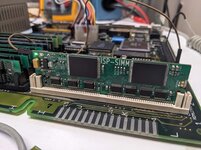zigzagjoe
Well-known member
This is a project I've had in the works for a bit in order to support a later project of mine. I expect to be doing a *lot* of reflashing, and removing and re-inserting the SIMM each time I wanted to iterate did /not/ appeal, so this is a 16MB ROM SIMM with onboard programming provided by a Pi Pico board. Result: it does not need to be removed from the mac it's currently installed in to write a new ROM image.
I'm still working on the code, in current form it erases, writes, and verifies a 1MB ROM image in 9 seconds. It'll slow down a little once I introduce USB (planning on UF2) support... but I'm already very happy with that performance.
I'm still trying to figure out what to have the pico do while idle; unfortunately due to the nature of the architecture of the board the pico only has visibility into the ROM control lines and lower bytes of the data bus of the ROM accesses. I'm thinking to have it act as USB-Serial adapter while not actively programming, at least.
Notable features...


I expect this will appeal to a very small demographic, but I've got parts for a few more of these and as code matures I'll likely post them for sale.
I'm still working on the code, in current form it erases, writes, and verifies a 1MB ROM image in 9 seconds. It'll slow down a little once I introduce USB (planning on UF2) support... but I'm already very happy with that performance.
I'm still trying to figure out what to have the pico do while idle; unfortunately due to the nature of the architecture of the board the pico only has visibility into the ROM control lines and lower bytes of the data bus of the ROM accesses. I'm thinking to have it act as USB-Serial adapter while not actively programming, at least.
Notable features...
- 16MB of flash (in two banks, switchable)
- Open-collector RESET output to be connected to the mac to hold Mac in reset while programming is in progress (release & boot when done).
- Expected to be Quadra compatible
- Detect +12v VPP on pin 2 and holds CS high to properly disable the onboard ROM
- Incompatible with the Lobos board flash utility; there's no Mac OS where we're going...
- GPIO/I2C/Serial Expansion header for later use


I expect this will appeal to a very small demographic, but I've got parts for a few more of these and as code matures I'll likely post them for sale.
